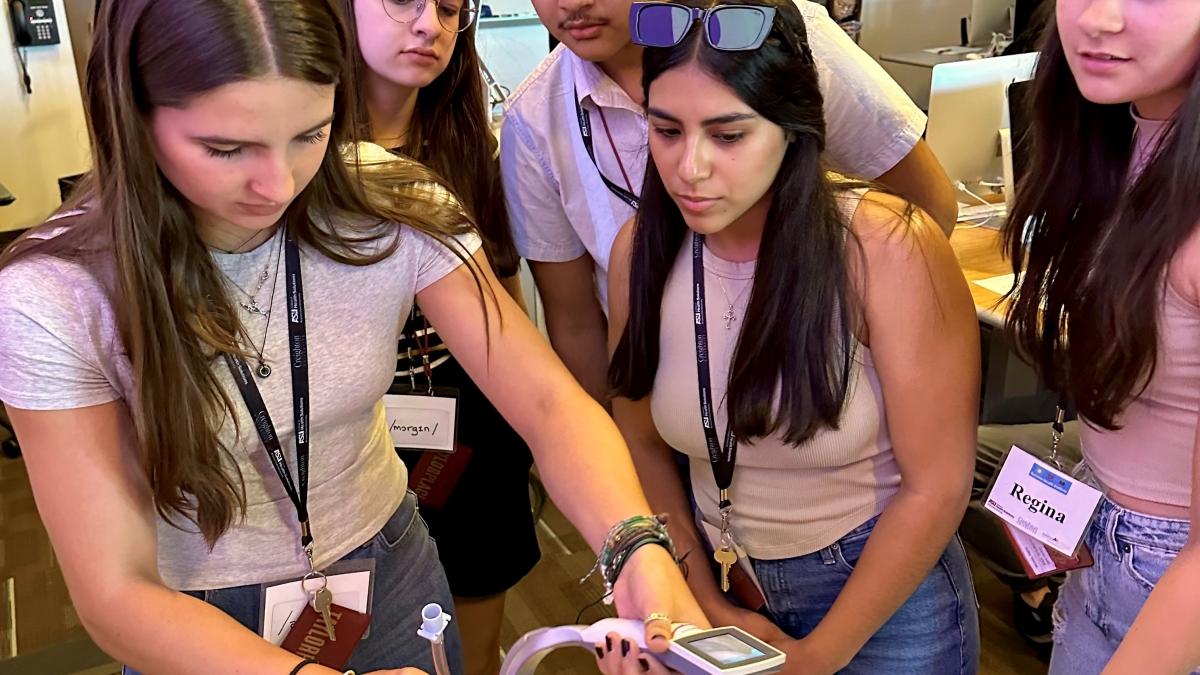College of Health Solutions’ Summer Health Institute secures new funding from The Burton Family Foundation

High school students take part in an intubation simulation during the Summer Health Institute, a partnership between ASU's College of Health Solutions and Creighton University Health Sciences Campus-Phoenix on June 29. Photo courtesy ASU College of Health Solutions
The Summer Health Institute, a partnership between ASU’s College of Health Solutions and Creighton University Health Sciences Campus-Phoenix, can look forward to stability and growth thanks to a new signature sponsor.
Due to generous support from The Burton Family Foundation, the weeklong summer camp (which launched in 2014) for high school students not only has funding for at least the next three years, it will be able to double the number of participants.
The Summer Health Institute is an opportunity for students from across the nation to learn about career options in health care while also being exposed to a college environment. The students (rising high school seniors) spend a week on ASU’s Downtown Phoenix campus in addition to three hours of daily interactive activities at Creighton University Health Sciences Campus-Phoenix, which partners with the College of Health Solutions to put on the camp.
Because of generous support from community partners, the only cost to participants in the Summer Health Institute is travel to and from the camp. Securing the $690,000 commitment from The Burton Family Foundation has helped make the goal of making sure cost did not stop students from attending easier, said Nate Wade, executive director and assistant research professor for the College of Health Solutions.
“We used to scramble to find funding for the camp,” Wade said. “We’ve always had sponsorship from multiple different donors over the past 10 years, but to find a sustainable sponsor who said, ‘Not only do we want to sustain it, but grow it and double the number of participants for the next three years,’ is tremendous.”
The foundation’s support is committed for three years with the potential for a longer relationship. It will make planning for upcoming camps easier, Wade said. The camps run in two sessions each summer. The 2023 sessions were held June 25–July 1 and July 9–15.
The new funding source will also allow the camp to double enrollment from the 48 students to 96. There were 168 applicants for the 2023 camps.
“Summer Health Institute brings students into a hands-on learning environment and allows them to experience firsthand how incredible careers in health care can be,” Dr. Jaya Raj, assistant dean of diversity, inclusion and belonging at Creighton University School of Medicine-Phoenix, said. “Our innovative partnership with ASU College of Health Solutions aims to eliminate perceived barriers so that more people will be able to envision themselves working in medicine. We are proud of this collaborative effort between our schools and the positive impact it is having within our community.”
Wade said it’s gratifying to hear from past participants in the camps who, in some cases, didn’t think college was an option before attending the Summer Health Institute.
“For the past decade, the Summer Health Institute welcomed high school seniors to the ASU campus at no cost for a weeklong, residential experience to explore a variety of health career pathways, encourage college-going behavior, meet peers with similar interests in health and health care, and research a specific genetic disorder throughout the week that culminates in a group presentation,” Wade said. “It is truly rewarding to know how positive of an impact the camp had on the personal and professional journey of so many participants. This sentiment was echoed to this year’s participants by a panel of alumni and previous camp counselors of the Summer Health Institute.”
Brooke Horne, a rising senior at Blue Ridge High School in Pinetop-Lakeside, Arizona, took part in the 2023 camp. She said the experiences presented were invaluable to her.
“I had the opportunity to learn from numerous health professionals and medical students,” Horne said. “I loved being able to explore many different areas of the medical field ranging from speech pathology to physician assistant. The hands-on experiences, like administering an IV or performing a physical, were my favorite parts of the ASU Summer Health Institute. After attending the camp, I feel determined and excited to pursue a future in the medical field.”
More Health and medicine

10 companies, 5 nations, 1 accelerator: A wide range of innovative health care solutions
The 10 companies participating in the 2025 Mayo Clinic and ASU MedTech Accelerator program hail from five different nations and…

'Incredible milestone': ASU, city of Phoenix announce location for ASU Health headquarters
Citing the need for a “new way” of doing things, Arizona State University President Michael Crow said that the headquarters for…

Have a health question? This newsletter is for you
You sprain a knee while playing basketball. Your stomach hurts all the time. You keep getting bad headaches.What’s the first…

